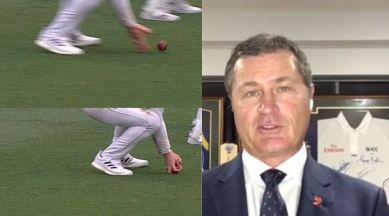Stay updated with the latest sports news across Cricket, Football, Chess, and more. Catch all the action with real-time live cricket score updates and in-depth coverage of ongoing matches.
Umpire Simon Taufel on controversial Labuschagne catch: ‘Can understand why South Africa feel hard done’
Michael Hussey, Adam Gilchrist, Mark Waugh reckon Labuschagne should have been given out caught by Simon Harmer

Controversy erupted over a catch by a South African slip fielder Simon Harmer who grabbed the edge by the Australian Marnus Labuschagne. The on-field umpire Paul Reifel gave the soft-signal of out but it was overturned by the tv umpire Richard Kettleborough. The opinions were divided.
What happened?
monthly limit of free stories.
with an Express account.
Australia were sailing along at 1 for 130, when Labuschagne edged Marco Jansen low to second slip. Harmer held onto the low catch but Labuschagne didn’t budge. The umpires conferred, and sent it upstairs with the soft signal out.
What did the replays reveal?
As ever with the case of these really low catches, the replays obfuscated the matter. The ball lands on the finger tips, the middle finger bends on impact and the question arose if the ball touched the ground in the process. Kettleborough kept it on a low simmer for a while, watching many replays for several minutes from different angles. He then ruled it not out.
Was there enough evidence to overturn to the ‘out’ decision conveyed by the soft signal?
The soft signal isn’t as sacrosanct as before. The former umpire Simon Taufel explained to Channel 7.
“The ICC did tweak its third umpire protocols in this area last year, where the soft signal in this particular case with a fair catch would carry less weight, only if the TV replays were inconclusive or poor, or non-existent,” Taufel said.
“So, Richard really had a tough job with that one, particularly because the camber of the ground slopes away. Obviously Richard felt that the ball hit the ground before getting into the hands. It’s a tough call.
“That’s where the foreshortening of the lens really becomes a little bit deceptive, when you look at it front on. I think that’s why Richard started with that side-on shot to start with because it looks like the ball is dipping down, but sometimes you’ll get that half-frame in between the ball dipping down and the ball going up, and that’s why the side-on shot is sometimes the better one for the third umpire to look at, but I can understand why South Africa might feel a bit hard done by there.”
What did former players feel about it?
Let’s start with Michael Hussey.
“I feel as though the South Africans can be quite aggrieved here. The soft signal was out. I felt like the ball landed on the fingers and he was able to scoop it up. His fingers are down, it hits the top of the fingers, pushed it back. I don’t think there’s conclusive evidence there to overturn that decision. That’s just my opinion,” he told Fox Cricket.
Mark Waugh then chimed in.
“That could go either way, let’s be honest. It was tough to tell. I thought front-on it probably looked out, but side-on there was enough doubt there,” said Mark Waugh on Fox. “They could count themselves a little unlucky the South Africans. Live it looks okay, that catch. They often do live … that’s probably why Paul Reiffel gave the soft signal as out. I think it’s a real 50-50 call.”
But Kerry-o-Keefe took up the case on the Kettlebourough’s side with this gem. ““There was enough grass under that to feed a growing cow.”
Former Australian captain Adam Gilchrist sided with the South Africans. “I’m not convinced I’ve seen that, with certainty, can turn that decision around the other way.”